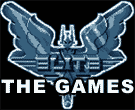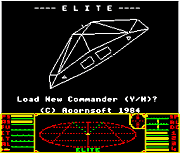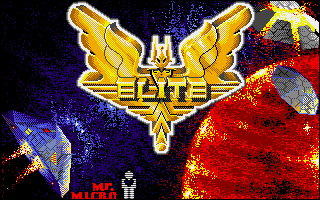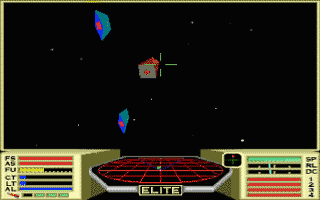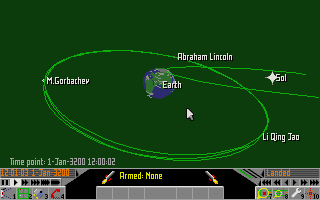
Elite was written by David Braben and Ian Bell and released for the BBC Microcomputer in 1984. It has been ported to most other platforms, including IBM/PC, Commodore 64, Amiga, Acorn Achimedes, Atari ST and the Nintendo Entertainment System. Elite was one of the first 3D games for home computers and has been voted among the top 10 'Best game of all time' on several occations. Elite was also one of the first 'open ended' games and many people still play it, possibly with the same commanders as in the 80's. Elite is set in a fictional universe consisting of 8 different galaxies, each containing hundreds of solar systems with space stations, moons and planets. The player begins with a Cobra MkIII space craft. A minimum of equipment, weapons and small amount of money. The player also has combat rating ranging from 'Harmless' to 'Elite. It is based on the amount of enemy ships destroyed and getting the prestigious 'Elite' rating will require both skill and hard work.
The game starts at a space station orbiting the planet Lave. The player is then free to invest his limited resources in any type of goods available for purchase at the market and then try to find a suitable system to sell these in. To his help he has a detailed starmap with descriptions of each system, its inhabitants, technological level and criminal activity. The Cobra uses a drive system that catapults the ship into a dimension called "Witch Space" or more popular "Hyper space". The jump to another system takes only fraction of the time it would take in normal space and the ship emerges (hopefully) intact in the outskirts of the targeted system. The player now have to rely on a 'compass' to steer his ship to the closest space station. During the trip to the station anything can happen. Pirates often prey on unprotected traders and if you have a criminal record the police might be after you too. The greatest danger though, comes from the mysterious insectoids known as "Thargoids". These aliens sometimes attack a ship passing through Witch Space and their large octagonal battle cruisers are exceptionally deadly. Once you reach the safety of the station and manage to dock, you can refuel your ship, sell your cargo and, if you have the cash, upgrade your ship with better weapons or equipment. Now the rest of the galaxy lies open for you, if you have the guts and the skill to survive and become one of the Elite!
Where to get itAll versions can be found on Ian Bell's homepage, along with the only true Elite story "The Dark Wheel", a must-read for anyone interrested in Elite or good sci-fi stories. The "Space Traders Flight Training Manual" from the original elite can also be found on his site. I recommend Elite Plus or Archimedes Elite if you like to try it out. The Amiga version of Elite is also very nice. Frontier: Elite 2
Frontier is the sequel to Elite. It was written by David Braben in 68000 assembler code and released for the Amiga in 1993. The game was ported to 80286 assembler code the same year by Chris Sawyer for the IBM/PC. It has won several awards and is regarded as a genuine classic. Unlike Elite, the main focus in Frontier was realism. The game's engine simulates our entire universe. Stars systems are located according to current data and planets move in correct orbits. (check out Zat Solo's page for an in-depth analysis). The game engine also uses Newtonian physics. This is something that hits players of "standard" space sims the hardest, they often find themselves flying into stars, planets and other assorted space objects. This is because, unlike Elite, your space ship doesn't automatically stop when you don't apply thrust. In Frontier you will find that you have to spend several days (game time, of course) decelerating when flying in thousands of kilometers per second. In Frontier, unlike Elite where you could only dock with space stations, there are planets with huge starports where you can land (just don't forget shielding, or you will burn up in the atmosphere). Frontier also introduce the BBS where you can buy/sell and contact people about missions. The stations and ports also include a shipyard where you can buy new ships, a stockmarket where you can sell your cargo, and a black market where you can deal in illegal goods, just look out for the police!
You start out on the ice world of Merlin in the Ross 154 system, close to Sol. In your possession is a tiny fighter ship, a Eagle Long Range Fighter, and 100 credits. Like in Elite, it's up to you to head out in the galaxy and make a try for glory and gold. Frontier also introduces two superpowers, The Federation and The Empire and you can decide if you want to enlist with either of their navys or take missions from both sides. What was in the box?I judge a game by it's manual and accessories. If a game has a good accessories it usualy means that the developers have taken their work seriously. For example take a look at Homeworld. This is one of the best games of the end 90's and the manual is excellent. 300 pages with background story, nice illustrations and data... hmmm I'm getting sidetracked here, back to Frontier. Fortunatly Frontier's box is filled with juicy stuff:
Where to get itFrontier can be downloaded from The Official Elite Club. If you already own the game you are free to use it as long as you like. If you don't, it is considered a shareware version and you have to pay a small sum to continue using it more than 30 days. You can also download the manual in HTML format. Hopefully Frontier Developments will make the Gazetteer and Stories... available in a soon future. Frontier: First Encounters
First Encounters was first supposed to be an add-on to Frontier but grew into a stand-alone game. It was developed by David Braben and his newly started company, Frontier Developments. FFE was released in 1995 and was well reviewed, however, the game was heavily bugged and many people couldn't even get it to start. As a result, sales dropped rapidly and the game was recalled from the shops. Several patch disk were released, the latest version is 1.06 and makes First Encounters as stable as most games. The stabilety issue was due to the fact that the game had been released much too early, many of the later parts of the game didn't work and the team had probably not had time to test it properly. This was later the cause of a lawsuit/counter lawsuit between Braben and the publisher Gametek. It all ended in favor of Braben and Gametek was forced to pay them a handsome amount of money. Now lets leave all that behind us and look at what's good with First Encounters. The graphics are much improved over Frontier and each planet has it's own unique geography with high mountains, deep canyons and shorelines that would fill Slartibartfast with envy. The game introduces 23 additional ships and a third super power - The Alliance, a much more democratic and just organisation (or a bunch of sissies, depending on your point of view). Another big improvement over Frontier was the introduction of an actual storyline. There are several stand-alone missions and a campaign involving the Thargoids, who was mysteriously missing from Frontier. There are also five independent newspapers that report events in the galaxy (a good source for tips on missions), and they often mention your progress in some form or another.
What was in the box?First Encounters was released in two diffrent boxes. One for UK and Europe and one for the US. The UK version is much more stylish, with a ringed gas giant apposed to the US version that features a big, green, 'war of the worlds' -like hand. However (to my knowledge) they contain the same material:
Where to get itThe latest version of First Encounters can be downloaded from The Official Elite Club. If you already own the game you are free to use it as long as you like. If you don't, it is considered a shareware version and you have to pay a small sum to continue using it more than 30 days. If you want to run FFE in Windows with DirectX you can download John Jordans excellent "patch". The First Encounters manual can be found on-line here. Elite IVFrontier Developments have reported that they are starting the development of the fourth episode in the Elite series. The game is predicted to be finished earliest in 2004. Here are some things that probably will be in the game:
More info about Elite 4 can be found on Frontier Developments site and on the FNBS Problems running the gamesDo you have problems with memory or does your game run too fast, consult my problems page here. |
||||||||||||
